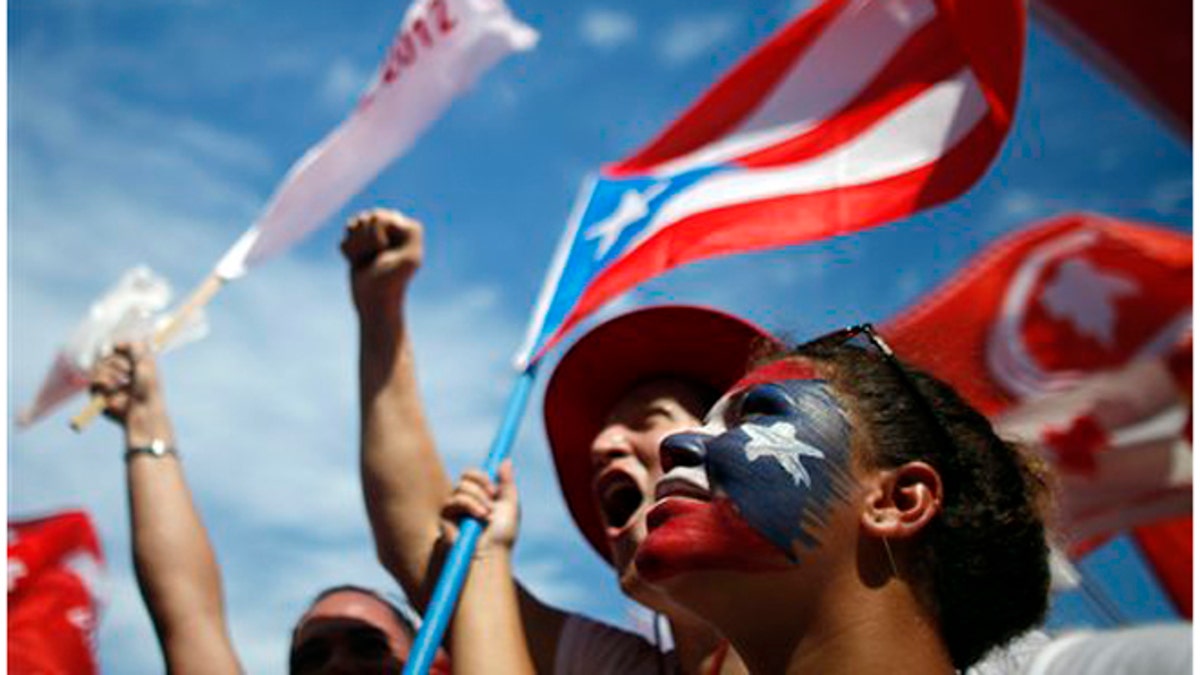
Supporters of Alejandro Garcia Padilla, candidate for governor of the pro-commonwealth Popular Democratic Party, cheer during his closing campaign rally in San Juan, Puerto Rico, Sunday, Nov. 4, 2012. Puerto Rican voters will once again ponder the decades-old question over the island's political future when they go to the polls Tuesday: What kind of relationship do they really want with the United States? Officially, the Caribbean island is the U.S. Commonwealth of Puerto Rico, a semi-autonomous extension of the U.S. mainland, its giant neighbor 1,000 miles to the northwest. (AP Photo/Ricardo Arduengo) (AP)
Detroit, once known as an American manufacturing and economic powerhouse, is now better known for high crime, low employment, run-down neighborhoods, and financial mismanagement that have turned the city into the largest bankrupt municipality in the U.S. Will Puerto Rico be next?
Unfortunately, Puerto Rico is now in worse condition than all of the eight cities that have filed bankruptcy since 2010. Puerto Rico’s long-term financial bungling, high unemployment, growing emigration, and poor economic outlook have caused bloggers and pundits to often change its nickname from la Isla del Encanto to el Detroit del Caribe.
What the island needs now are more leaders willing to put aside short-term election prospects and make the unpopular decisions that will attract business and economic growth.
Some say the economic comparison isn’t fair given the difference in population and size (Detroit has 706,000 people compared to Puerto Rico’s 3.7 million), notwithstanding the fact that nuestra pátria is one of the most beautiful places on the planet while Detroit - well, it’s not. However, compared to Detroit, Puerto Rico may be in even worse condition.
While Detroit had debt due of nearly $18 billion before its final breath, Puerto Rico is butting against $87 billion. With a GDP of only $96 billion, Puerto Rico’s debt-to-GDP ratio (a lower percentage is considered to demonstrate better financial health) is 91 percent. High by any measure, this ratio is still relatively low compared to the U.S. as a whole, which surpasses 100 percent, and certainly fares better than Greece at nearly 175 percent. In this light, Puerto Rico actually looks like it’s doing pretty well.
The problem, however, is that Puerto Rico doesn’t have the backing of the economic powerhouses that are the U.S. government and the E.U. Because of this relative economic seclusion, Puerto Rico has been effectively shut out of raising more money in the bond market and now has to finance itself with credit from banks or various other short-term measures. In essence, our island has to take drastic measures now (and I mean right now), or it’s going to have even more serious problems very soon.
If you’re from the island, you know that the economy has been bad (some say horrible) for years. Decreasing unemployment opportunities are one of the biggest reasons so many young people leave the island for the greener pastures of the U.S. mainland. The unemployment rate peaked at 16.9 percent in early 2010 and fell, albeit quite slowly, to a low of around 14 percent in mid-2012. Some attributed the drop to the drastic measures of the previous administration under Governor Fortuño, which included reducing the government payroll, cutting other government spending, and implementing tax measures to attract new business and foreign investment.
The tides have seemingly turned for the current administration, which took over in 2013 led by Governor García Padilla. Puerto Rico has seen an unfortunate decline in economic activity, increase in debt, and continued decreasing employment in 2013.
Now here’s the kicker if you’re not from Puerto Rico or know little about it. Puerto Rico, unlike Detroit, does not have the option to file for bankruptcy. Some say that this forces Puerto Rico to react responsibly, ensuring that it takes care of the debt it has piled up. Others say that this leaves only one option: the dreaded bailout.
Now, why would the rest of the country want to bail out Puerto Rico? Well, you may be surprised to know that you probably hold Puerto Rican bonds in your portfolio. Due to Puerto Rico’s status it has been able to offer municipal bonds with what’s called “triple exemption.” Buy a bond guaranteed by the government of Puerto Rico and your gains are exempt from federal, state, and local taxes, an advantage you won’t find anywhere else.
Fortunately, or unfortunately depending on which side of the debt you are on, Puerto Rico’s riskier financial status has also led to an increase in its bond yield, which means that Puerto Rican bonds are paying nearly 9 percent, tax free. That hard-to-beat investment has led it to become one of the most popular options for money managers, and probably something you hold in your mutual fund, 401(k), or pension and don’t even know it.
The Puerto Rican government is working pretty hard to stay afloat by convincing bondholders and credit raters that it’s going to pull out of its financial hole before defaulting on its massive debt. Some say that the movers and shakers on the island are spending more time in New York and Washington than at home to ensure fiscal trust and investment continues. Others say, the inevitable is yet to happen and the rest of the country is going to have to bail out the island.
Bailout or not, Puerto Rico has some significant and serious economic changes to make. American taxpayers have their own debt and financial concerns and could not be more adverse to another bailout. Puerto Ricans would much rather see economic growth and prosperity than handouts.
What the island needs now are more leaders willing to put aside short-term election prospects and make the unpopular decisions that will attract business and economic growth to Puerto Rico, stop the massive exodus of its youth to the mainland, and ensure long-term growth and prosperity.
But they better work fast. If the U.S. doesn’t solve its own debt problem, Puerto Rico may have nowhere to turn, but down.
